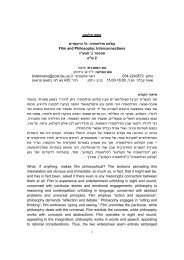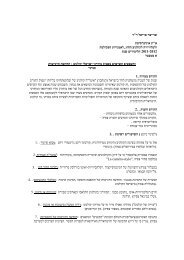The Iconography of the Temple in Northern Renaissance Art
The Iconography of the Temple in Northern Renaissance Art
The Iconography of the Temple in Northern Renaissance Art
Create successful ePaper yourself
Turn your PDF publications into a flip-book with our unique Google optimized e-Paper software.
<strong>the</strong> Vatican, which for <strong>the</strong> Catholic world symbolises <strong>the</strong> Holy Church. In <strong>the</strong><br />
Betrothal, as well as <strong>in</strong> o<strong>the</strong>r works by Fouquet, <strong>the</strong> traditional anti<strong>the</strong>sis between<br />
<strong>the</strong> <strong>Temple</strong> as Synagoga and <strong>the</strong> <strong>Temple</strong> as Church is replaced by an assimilation<br />
<strong>of</strong> <strong>Temple</strong> and Church. 45<br />
In Fouquet's Antiquités Judaiques, <strong>the</strong> Construction <strong>of</strong> <strong>the</strong> <strong>Temple</strong> (Paris, B.N.<br />
lat. 247, fol 163 r ) is depicted as if it were <strong>the</strong> build<strong>in</strong>g <strong>of</strong> a ca<strong>the</strong>dral, and is<br />
<strong>in</strong>terpreted <strong>in</strong> some biblical commentaries as <strong>the</strong> Establishment <strong>of</strong> <strong>the</strong> Church. 46<br />
In Paul<strong>in</strong>e <strong>the</strong>ology <strong>the</strong> Construction <strong>of</strong> <strong>the</strong> <strong>Temple</strong> is considered as a metaphor<br />
for <strong>the</strong> Construction <strong>of</strong> <strong>the</strong> Ideal <strong>Temple</strong>, 47 or <strong>the</strong> Spiritual <strong>Temple</strong> (<strong>the</strong> Church,<br />
or <strong>the</strong> Heavenly <strong>Temple</strong>), <strong>of</strong> which Christ's Body is <strong>the</strong> cornerstone. 48<br />
<strong>The</strong> Destruction <strong>of</strong> <strong>the</strong> <strong>Temple</strong> was generally <strong>in</strong>terpreted as <strong>the</strong> chastisement<br />
<strong>of</strong> <strong>the</strong> Jewish people who had refused to recognise Christ. <strong>The</strong> Church was<br />
dest<strong>in</strong>ed, <strong>the</strong>refore, to supplant <strong>the</strong> ru<strong>in</strong>ed <strong>Temple</strong>. 49 Fouquet's illustration <strong>of</strong><br />
this subject does not adhere to <strong>the</strong> traditional motif. <strong>The</strong> Destruction <strong>of</strong> <strong>the</strong><br />
<strong>Temple</strong> by Nebuchadnezzar <strong>in</strong> <strong>the</strong> Antiquités Judaiques (ibid. fol. 213 v ), does not<br />
show <strong>the</strong> <strong>Temple</strong> as <strong>the</strong> traditional ru<strong>in</strong>ed Synagogue but as a Gothic ca<strong>the</strong>dral.<br />
Accord<strong>in</strong>g to Deutsch, 50 <strong>in</strong> giv<strong>in</strong>g <strong>the</strong> ru<strong>in</strong>ed <strong>Temple</strong> this form, Fouquet is<br />
referr<strong>in</strong>g to <strong>the</strong> metaphor <strong>of</strong> <strong>the</strong> Eternal <strong>Temple</strong>, <strong>the</strong> Celestial <strong>Temple</strong>. In <strong>the</strong><br />
background <strong>of</strong> this illustration <strong>the</strong> prophet Jeremiah laments <strong>the</strong> Destruction.<br />
<strong>The</strong> Destruction <strong>of</strong> <strong>the</strong> <strong>Temple</strong> may also prefigure <strong>the</strong> Crucifixion. In a 13th<br />
century Bible Moralisée (Paris, B.N. lat. 1156, fol. 156 v ), <strong>in</strong> <strong>the</strong> illustration to<br />
Lamentations 1:1-4, <strong>the</strong> ru<strong>in</strong>ed <strong>Temple</strong> is depicted as a Gothic church, while<br />
<strong>the</strong> Crucifixion is represented <strong>in</strong> <strong>the</strong> commentary medallion.<br />
In ano<strong>the</strong>r episode from Josephus Flavius, Herod's Triumphal Entry <strong>in</strong>to<br />
<strong>the</strong> <strong>Temple</strong> (Guerres des Juifs, Paris, B.N. n.a. fr. 21013 fol. 1 v ), Fouquet aga<strong>in</strong><br />
transforms <strong>the</strong> <strong>Temple</strong> <strong>in</strong>to a Gothic ca<strong>the</strong>dral. <strong>The</strong> Holy <strong>of</strong> Holies is depicted<br />
as a high altar and <strong>the</strong> High Priest as a bishop. Herod himself is seen outside<br />
<strong>the</strong> <strong>Temple</strong> Enclosure, <strong>in</strong> front <strong>of</strong> <strong>the</strong> Pool <strong>of</strong> Purification which, as a s<strong>in</strong>ner<br />
and a crim<strong>in</strong>al, he cannot cross. 51 <strong>The</strong> way to <strong>the</strong> <strong>Temple</strong> - <strong>the</strong> True Faith - is<br />
blocked, <strong>the</strong>refore, by <strong>the</strong> cruel and lawless k<strong>in</strong>g, who sullies <strong>the</strong> Pool <strong>of</strong><br />
Purification. Deutsch remarks that <strong>the</strong> K<strong>in</strong>g and <strong>the</strong> Priest are deliberately<br />
represented as turn<strong>in</strong>g <strong>the</strong>ir backs to one ano<strong>the</strong>r, to <strong>in</strong>dicate <strong>the</strong>ir antagonism. 52<br />
In <strong>the</strong> <strong>Temple</strong> we aga<strong>in</strong> f<strong>in</strong>d <strong>the</strong> typical torsed columns for <strong>the</strong> Holy <strong>of</strong> Holies,<br />
but <strong>the</strong> Menorah, <strong>the</strong> Ark and <strong>the</strong> Cherubim which can be seen <strong>in</strong> <strong>the</strong> Entry <strong>of</strong><br />
Pompey <strong>in</strong>to <strong>the</strong> <strong>Temple</strong> (Paris, B.N. fr., 247, fol. 293 v ) have been replaced by a<br />
triple Gothic niche which transforms <strong>the</strong> <strong>Temple</strong> <strong>in</strong>to a Church.<br />
In represent<strong>in</strong>g Herod outside <strong>the</strong> <strong>Temple</strong> Enclosure, Fouquet is referr<strong>in</strong>g<br />
to a traditional motif, formulated ma<strong>in</strong>ly <strong>in</strong> <strong>the</strong> commentary illustrations <strong>of</strong><br />
French Bibles Moralisées, from <strong>the</strong> 13th century onwards. In a moralization to<br />
156
















